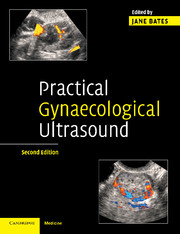Book contents
- Frontmatter
- Contents
- List of contributors
- Preface
- 1 Equipment selection and instrumentation
- 2 Practical equipment operation and technique
- 3 Anatomy, physiology and ultrasound appearances
- 4 Pathology of the uterus, cervix and vagina
- 5 Pathology of the ovaries, fallopian tubes and adnexae
- 6 Ultrasound in the acute pelvis
- 7 Ultrasound and fertility
- 8 Paediatric gynaecological ultrasound
- 9 Clinical management of patients: the gynaecologist's perspective
- Index
- References
2 - Practical equipment operation and technique
Published online by Cambridge University Press: 04 March 2010
- Frontmatter
- Contents
- List of contributors
- Preface
- 1 Equipment selection and instrumentation
- 2 Practical equipment operation and technique
- 3 Anatomy, physiology and ultrasound appearances
- 4 Pathology of the uterus, cervix and vagina
- 5 Pathology of the ovaries, fallopian tubes and adnexae
- 6 Ultrasound in the acute pelvis
- 7 Ultrasound and fertility
- 8 Paediatric gynaecological ultrasound
- 9 Clinical management of patients: the gynaecologist's perspective
- Index
- References
Summary
Practical approach to image optimisation
Arguably the first consideration in choosing a machine is the quality of the image in terms of resolution. Equipment differs significantly, and should be carefully evaluated before purchase by someone with experience in gynaecological ultrasound. Cost is not necessarily an indicator of quality of image, and in some cases it may be advisable to forgo elements of advanced functionality in favour of a basic, good-quality image.
Intelligent, informed operation of even a basic system is the key to accurate diagnosis. There are a number of controls which can be found on even the most basic systems which, if used correctly, offer significant improvements in image quality which can inform the appropriate patient management. The practical improvements that can be made by the operator to the image are underpinned by an understanding of the theoretical principles outlined in Chapter 1.
As demonstrated in Chapter 1, using the tissue-equivalent phantom, the image should be optimised using the focal zones, frame rate and line density, frequency manipulation and other image-processing options.
Frame rate and line density
The pelvic viscera are usually stationary targets and, as such, can be examined using a relatively low frame rate. This has the effect of increasing the line density with a consequent improvement in diagnostic information (Fig. 2.1).
Focal zone
The focal zone, which corresponds to the area where the beam is narrowest, should be aligned against the structure under examination, e.g. the ovary.
- Type
- Chapter
- Information
- Practical Gynaecological Ultrasound , pp. 15 - 31Publisher: Cambridge University PressPrint publication year: 2006



